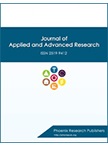Evaluation of genotype by environmental interaction and stability of early maturing fodder oat genotypes in highland of Bale, Oromia, Ethiopia
DOI:
https://doi.org/10.21839/jaar.2024.v9.9119Keywords:
AMMI Stability, Dry matter, Early Maturity, Quality ParametersAbstract
Selection of stable genotypes that interact less with the varying environment in which they are to be grown is required. The major objectives of the present study were to (i) assess the stability and yield performance of advanced Early maturing fodder Oat accessions evaluated in multiple environments, and (ii) identify stable high biomass yielding candidate cultivar(s) for possible release. A total of 19 fodders Oat accessions were evaluated against Dumant-2007 across four locations from 2022 to 2023 main cropping seasons. Randomized complete block designs (RCBD) with three replications were used. The AMMI analysis of variance for forage dry matter yield revealed highly significant (P<0.05) differences for days to flowering, days to maturity, plant height, leaf to steam ratio, seed yield, thousand seed weight and dry matter yield. The findings revealed that the highest forage dry matter yield was recorded for genotype 5448 (21.6 t/ha) and genotype 5447(21.5 t/ha) respectively. The higher leaf to steam ratio was recorded from both genotype 5447 and genotype 5448. Numerically the higher seed yield was obtained from 5447 (32.6 qt/ha), whereas the lowest seed yield was produced from genotype 5460 (21.2 qt/ha). The analysis of chemical compositions showed significant (p<0.05) differences for CP parameters among tested genotypes. The highest (12.290%) CP content was recorded from genotype 5448 followed by genotype 5447 (11.963%) whereas the lowest (9.41%) CP was recorded from 5449. The analysis of variance for AMMI also revealed significant variation for genotypes, environment and genotypes by environment interaction. The sum of squares for the first two IPCAs cumulatively contributed to 90.2% of the total GEI. Generally the mean performance, yield and stability of genotype 5448 and genotype 5447 were high and stable across the tested locations. Therefore, genotypes genotype 5448 and genotype 5447 were recommended to be promoted to a variety verification trial for further evaluation and possible release.
Downloads
References
Adugna, T. (2007). Feed resources for producing export quality meat and livestock in Ethiopia. Ethiopia Sanitary and Phytosanitary Standards and Livestock and Meat Marketing project (SPS-LMM).
Buerstmayr, H., Krenn, N., Stephan, U., Grausgruber, H., & Zechner, E. (2007). Agronomic performance and quality of oat (Avena sativa L.) genotypes of worldwide origin produced under Central European growing conditions. Field Crops Research, 101(3), 343-351. https://doi.org/10.1016/j.fcr.2006.12.011
Dawit, A., & Teklu, W. (2014). Determination of optimum seed rate and fertilizer rate for fodder oat in Bale Highland southern eastern Ethiopia. International Journal of Soil and Crop Science, 2(7), 73-76.
Dawit, A., Meseret, T., & Nebi, H. (2022). Effects of Sowing Time on Agronomic Traits, Yield and Nutritive Quality of Fodder Oat at Kofele Districts of West Arsi Zone of Oromia, Ethiopia.
Dawit, A., Meseret, T., & Nebi, H. (2023). Effects of Sowing Time on Agronomic Traits, Yield and Nutritive Quality of Fodder Oat at Dodola and Kofele Districts of West Arsi Zone of Oromia, Ethiopia.
Gebremedhn, B., Alemu, A., & Hailay, G. (2015). Evaluation of different oat varieties for fodder yield and yield related traits in Debre Berhan Area, Central Highlands of Ethiopia. Livestock Research for Rural Development, 27(9), 170.
Gemechis, L., Negassi, A., & Teklu, W. (2024). Evaluation of Biomass Yield, Seed Yield, Chemical Composition, and Compatibility of Vetch and Oats Varieties Mixtures. MSc. Thesis, Haramaya University.
Lodhi, A., Ghauri, B., Khan, M. R., Rahman, S., & Shafique, S. (2009). Particulate matter (PM2. 5) concentration and source apportionment in Lahore. Journal of the Brazilian Chemical Society, 20, 1811-1820. https://doi.org/10.1590/S0103-50532009001000007
Maleda, B., & Mastewal, B. (2013). Role of seeding rates and cutting stages on yield and quality of forage intercropping in the case of North Gondar, Ethiopia. Germany: LAP, LAMBERT Academic Publishing.
McLeod, A. (2011). World livestock 2011-livestock in food security. Food and Agriculture Organization of the United Nations (FAO).
Muleta, D., Taklu, B., & Gedefa, S. (2022). Adaptation trial of Oat (Avena sativa) Varieties in Two Agro-ecologies of Buno Bedele and Ilu Abba Bor Zones, South Western Oromia, Ethiopia. International Journal of Current Research and Academic Review, 11(3), 26-31. https://doi.org/10.20546/ijcrar.2023.1103.003
Tewodros, T., Kebebe, E., & Waktola, T. (2007). Operational research and capacity building for food security and sustainable livelihoods. Proceeding of Irish Supported Operational Research Project review Workshop, Hawassa.





 .
.